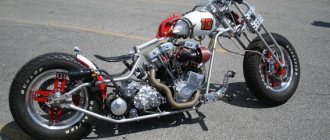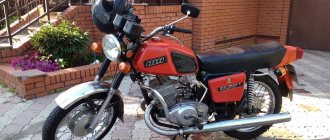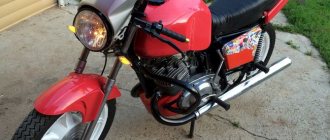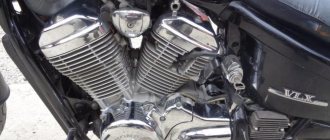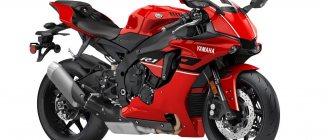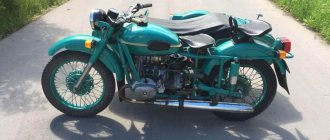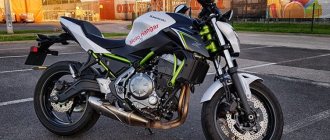Let's take a closer look at what the Honda Steed 400 is: technical characteristics, maintainability, operational features, pros and cons. Here are practical tips on what you should pay attention to when choosing a motorcycle, as well as what the future owner can expect from Steed. This information will be useful to those who have decided to buy a bike, but doubt the right choice. This is not a sponsored post and all information and opinions provided are unbiased and true. So let's get started.
How to choose your first bike if you want a chopper?
The question of choosing your first motorcycle is always relevant. To date, thousands of publications have been written that describe hundreds of mots recommended for beginners. But only one of them was and remains the best. This is a Honda Steed 400 vlx. And it’s not just that its engine size is “forgiving of mistakes” with inexperienced driving.
It has enough power to be a biker's companion for many years. Repair and maintenance of the Honda Steed 400 is simple and inexpensive. This motorcycle is reliable and unpretentious. Change the oil and pads, fill it with gasoline, and it's always ready to go. But first things first.
So my second season on Steed has come to an end. I have already described my first impressions of this motorcycle here, and now I would like to tell you more detailed information. One thing I will say for sure - riding this motorcycle continues to evoke an inexplicable, irrational feeling of delight, independent of numbers, horses, acceleration and other characteristics. Carburetors
Over these two seasons, Shame blew my mind a little. Well, a little bit. Sometimes I wanted to pour gasoline on it and set it on fire)) The carburetors brought the most emotions. Oh, this mysterious miracle of the Japanese motorbike! No not like this. Oh, this mysterious miracle of the armless collective farm! Well, at least I don’t know what else such problems could be associated with.
In general, the carbs were enriched. Moreover, in traffic jams at near idle they even filled it up. The motorcycle began to run unevenly, the speed fluctuated. He farted and sneezed, tried to stall, and when releasing the gas and braking the engine, he fired a deafening forward flow. After replacing the membranes and needles it got a little better, but still not the same. The candles were black, the appetite was like that of a Horse, well, at least it stopped pouring. Verdict - collective farm or the wells of the dosing needles are worn out (and in these keikhins the wells are pressed in and are not intended for replacement). A moto with a direct flow, just a real true Thunderheader, who knows what the butts were hit there. Everyone tried to tune these carbs. And masters at different motorcycle service stations, and my husband and I did it ourselves. I re-read all 109 pages of the topic about carburetors on the stidoforum, I already know what levels to set in the float chamber, how and where to blow, what to turn, how to adjust the mixture quality using the tachometer, and in general I can give lectures on these topics))) At least a couple of times per Steed was dismantling the season for another attempt to set up a normal mixture. But now you can set a record for the fastest disassembly and assembly of Steed))))
No, he was driving. In principle, it worked normally and never failed. But the realization that something was wrong with the technology was simply infuriating. As a result, in the middle of the second season, another carbs were purchased. And all the problems with the mixture were solved in one fell swoop! (True, during the first launch and setup on new carbs, just in case, I put an angle grinder in front of Steed so that he could see). The spark plugs are beautiful, the consumption is 4 on the highway, the engine runs smoothly, there are no failures, it produces its maximum speed - there’s simply nothing to complain about. The horse is dead - get off, as they say. If a spare part is worn out, you don’t have to suffer and spend half a season endlessly trying to adjust something. You just need another, working spare part, and everything will be fine!
Shame Shame
The second problem, which was mind-blowing a little at a time, was the age of the rubber bands. The first thing that was discovered was moisture near the brake machine. It was already slurping. We went to look - and there the boot had dried out, several kilograms of dirt (possibly even Japanese) had accumulated under it, causing the GTZ piston to partially rust, and the cuffs began to leak brake fluid. They removed the car, took it home, washed it, went through it, replaced the worn parts with new ones from the repair kit, and put everything back together. Life hack - it is best to pump the front brake from the bottom up, using a syringe. It is easier to push air bubbles up than to push them down.
The second wet moment was associated with the dried rubber of the radiator cap, which also acts as a valve to the expansion tank. After driving along the highway, leaks were discovered on the top of the radiator. Using the search method, we found a plug in which the rubber seal was all cracked and was leaking when the pressure in the system increased. The cork was picked up from some car without any problems.
Well, the third important point is the drive sprocket shaft seal. At first they thought that the oil pressure sensor was sweating because it leaked under the cap (protective boot). But it turned out that it was the oil seal, it was flowing from top to bottom, and even the oil filter was completely clogged, which made people think that it was it. After replacing the drive sprocket seal (and at the same time the gearbox shaft seal, let it be, old age does not benefit the rubber bands) Steed stopped pissing. Now I know that for the next ten years there will definitely be no sweat in these nodes!
Service
There were no more breakdowns or troubles. If there was more finance, it would be ideal to change everything at once. All seals, boots, hoses, cables, etc. But since this is too expensive for our budgets, everything was done gradually.
In general, what follows is banal. The oil and antifreeze, front and rear pads, cables, brake fluid, chain and sprockets, clutch, fork seals and boots were changed. Hmm, that seems to be all for now.
Improvements
I got the motorcycle already with bars and a luggage system. Which is very cool, because it’s all made well, from stainless steel, and to do it just as beautifully and well would be very financially stressful.
What we have already done:
— Rear trunk. There is no arguing about tastes, I don’t need to talk about the bread box here, please)) The main thing is that I like it. And the useful volume, where you can load a bunch of everything you need, from a passenger helmet to a couple of shopping bags for a week, completely negates all possible shortcomings. And also this constant from people without trunks: “And put my Coke in,” “Can I hide my jacket for you?” and so on. speaks for itself)))
— Remaking the rear shock absorber. This is simply a great thing! Over the years of driving on our roads, the spring sagged and began to break through. I found many different options on the Internet, from trying to insert a shock absorber from some other motorcycle (usually this immediately lifts the motorcycle’s ass up and looks very bad), to ordering another used shock absorber from Steed (with an unknown result, what if it’s like this sagging), or buying all sorts of YSS for crazy money, which seem to fit, but are unreasonably expensive. So, the problem can be solved simply and inexpensively - the original spring is replaced with a spring from the cabin of a Hyundai truck. The result is that in hardness modes 2 or 3 it does not penetrate even with a total weight of the pilot and passenger of 160 kg. At the same time, at the same setting and under me alone, it’s quite soft, it doesn’t hit the spine. The perfect solution!
— I had to change the steering wheel. Well, as it happened - in principle, I went through the first season normally and with a “stick”, but still it was not particularly convenient. I’m not tall enough, I had to reach for the steering wheel, it was a bit hard to steer. Therefore, we found and installed a stock “Y”, which just fit perfectly into my hands. With it, people with short stature are much more comfortable - the back is straight, the seat is vertical, the arms are relaxed. Like in a chair!
- Headlight. The stock light in Steed is so-so, especially when more than half of the oncoming traffic comes with collective farm xenon. Therefore, a Chinese copy of Daymaker was installed, which even has some kind of certification and a cut-off line. Driving in the dark has become much more comfortable (but I still don’t like it).
- Windshield. Adds to the look of the motorcycle and really protects it from the wind. In the rain you remain practically dry. Homemade wind deflector, made of plexiglass.
— Windproof guards on the steering wheel. They really protect your fingers from the wind. Even in cool weather you can ride with summer gloves. Well they look cute 
- All sorts of little things. Voltmeter type, extra. lights on the arches and lights on the tank.
Summing up
After the completely problem-free new Yubra, the old 25-year-old motorcycle periodically pissed me off. Change this, change that, adjust this, repair this. Moreover, according to the law of meanness, often right in the season. And, it would seem, all this is trifles. Rubber bands, seals. In general, pf, not worth attention. The compression is excellent, the hone is perfect, the wiring works, there are no complaints about the motor. But damn. It still infuriated me. And then I sat back in the saddle, rode aimlessly, listened to the bubbling of the forward flow, saw a lame instrument in front of me, and a small teardrop-shaped tank under me, felt the weight of this cow (surprisingly, the same 400s Shadovki and Draghi seem many times more light, probably because of the trail), and again, again I got a thrill, realized how much I love this Motorcycle! I don't need speed indicators, number of horses, torque, and all that stuff. Choppers, cruisers, that's not what they're talking about. Love for them is incomprehensible and inexplicable. You can drive 40 in the city in traffic and not even have any desire to overtake. Or drag along the highway at 80, if you’re not in a hurry - and don’t want to accelerate further. Such a strange expression appears on your face, a mixture of a “brick face” and a slight smile, when you get a thrill simply from the very fact of riding your favorite Horse. And when you leave it in the parking lot, be sure to look back to admire it.
Appearance, character and a little history
This is a chopper whose appearance is not inferior to the legendary Harley. The low center of gravity gives the motorcycle stability. Sitting on it, the rider has a straight back. This fact makes the Honda Steed 400 a full-fledged representative of cruisers. The rider's legs are stretched forward and never become numb on long rides.
The Honda Steed 400 vlx was produced exclusively for the domestic Japanese market. There is also its brother, which is similar in appearance, and is called Honda Shadow. Despite all their similarities, they still differ and have design differences. A version with a 600cc engine was released for the American market.
But still, it was the Japanese four hundred that took the leading position in popularity among choppers. Here:
- V-shaped engine;
- abundance of chrome parts;
- wide rear wheel;
- characteristic landing;
- ideal proportions ensuring flawless contours.
All this is accompanied by outstanding technical characteristics. Let's talk about them.
For whom
Here are the main features of the machine:
- Four-speed gearbox;
- some minimalism in design and similarity to Steed 400;
- 44 Nm and 36 hp.
The motorcycle is not suitable for people who have just begun to master such motorcycles. The bike will be just right for those who have already ridden a lot on the Steed 400 and want to switch to a bike with the same design and dimensions. The Honda Steed 600 is so similar to its predecessor that, without looking closely at the details, they can easily be confused.
Honda Steed 400 technical characteristics and dynamics
The most striking characteristic of this bike was its “indestructibility”. This applies to both the engine and chassis. With simple care, a motorcycle can last for decades. Today on the roads you can find copies that were produced more than a quarter of a century ago. And if Steed had been produced earlier, then surely earlier bikes of this model would have crossed the landscape.
The list of technical characteristics of the Honda Steed 400 is as follows:
- engine type – V-shaped;
- cooling type – water;
- power unit volume – 400 cubic centimeters;
- number of cylinders – 2;
- number of valves - 2 for each cylinder;
- power – 31 horsepower;
- torque – 33 N.m.;
- number of transmission stages – 5;
- type of transmission of rotation to the wheel – chain;
- speed limit is 140 km/h.
Regarding dynamics, it is worth noting that up to 80 km/h this motorcycle is capable of very “vigorous” and high-torque acceleration. Above this, it suffocates, and the acceleration is sluggish. But on long runs this does not interfere at all. The only negative is that you need to be careful when overtaking vehicles driving along the highway at speeds over eighty. This motorcycle will not be able to “shoot” straight away.
Modifications
All Steed 400 models differed only in appearance, as well as in the nameplates on the sides. No changes were made to the running parameters. However, sometimes minor modifications entailed a whole redesign of the appearance, and although the model remained the same, in terms of size it was a completely different bike.
Despite the common content, the modifications of the bike turned out to be so different that, in addition to differences from competitors, the features must be considered separately.
VlX
Standard, basic equipment that existed on the assembly line throughout production.
Honda STEED 400 VlX - front view.
Honda STEED 400 VlX - rear view.
The Steed 400 VLX has undergone a dramatic change to the front suspension. In the first editions (until 1997 ), the front colossus was held by a stinger fork , which is essentially a type of pendulum. The decision was dictated by the desire to increase the working stroke. However, the non-standard solution did not find any adherents. The fork was changed to a regular telescope, although the settings remained for the stinger. This was reflected in the shortcomings of the model.
In other details it was a regular hopper. The front wheel is 19 inches , the rear wheel is 18 inches .
VLS
Modification of Honda STEED 400 VLS (V-Twin, L-Lowered, S-Springer front end).
Appeared in 1998 as a side development. But it did not arouse public interest, and it was closed that same year.
In terms of its dimensions, the model has become the smallest in the line. Less weight, increased maneuverability and speed. For better handling, the front wheel was installed at 21 inches . Despite this, the saddle height is 650 mm .
VSE
A distinctive feature of the VSE model is the rear cast wheel and the curved handlebar in stock.
Another side branch born in 1995 . Due to the fact that they wanted to use a different type of suspension during production, I received an improved frame. Collected until 1998 . Closed during the transition to production of a successor motorcycle.
Since the motorcycle did not become a classic chopper, the developers tried to transfer it to another class. To achieve this, in 1995 the frame was redesigned, the design was updated and cast wheels were installed - just like on sports. This aroused some interest, but in 1997 a newer model appeared on the market.
Peculiarities
Fuel tank.
Pointer speedometer.
In addition to what was described, the entire line had one common feature - an instrument panel made in the style of road workers. a dial speedometer above the steering tube . Below it are 3 warning lights:
- turns;
- high beam;
- neutral
No instruments were installed on the tank.
Honda Steed 400 suspension specifications
We deliberately separated this part of the review into a separate chapter, because the suspension of this device really deserves attention and a separate discussion. Again, she is “unkillable”. Front wheel travel is provided by a standard telescopic fork (for a regular Steed) or a multi-link fork (for a Steed with the vlx index).
The rear suspension is equipped with softail shock absorbers. This choice was made due to reliability and the resulting illusion of the absence of a rear fork. This equipment is enough to carry two people in addition to its own 200 kg. curb weight. Yes, the motorcycle is not light, but that’s how a chopper should be. The weight ensures stability on the road while driving.
Regarding riding two people on the Honda Steed 400, reviews indicate that with a height exceeding 180 cm, the motorcycle becomes cramped. This is where the small overall dimensions come into play. Let us remember that this model was produced for the Japanese market. Driving independently is truly a pleasure, and its small dimensions provide the necessary maneuverability in urban conditions.
Chassis and brakes
The bike is equipped with a tubular steel frame. She perfectly conveys his calm but strong character. The frame shapes are quite strict, even classic, but elegant. The body is very similar to that of the 400th model. Like its predecessor, the steering wheel is of medium size, and the wheels are spoked.
The pendulum suspension at the rear is equipped with a monoshock absorber, and at the front a telescopic fork acts as a suspension. A drum acts as the rear brake, while a dual-piston caliper and 296mm disc brake up front.
Practical characteristics of the Honda Steed 400
Considering the low gasoline consumption of 3.5 liters per hundred and an 11-liter tank, this motorcycle model can cover long distances without refueling. Comfort complements reliability. It is extremely rare to see a Steed on the side of the road due to a breakdown. All its components and assemblies have extreme endurance. Therefore, it can be used for commuter trips, as well as long-distance travel.
And in the city he behaves confidently and does not cause any trouble. Its weight is more medium than heavy. Therefore, it is not difficult to keep him at a traffic light. Water cooling prevents the engine from overheating even in a traffic jam. Despite the fact that the power characteristics cannot be called outstanding, this motorcycle can be easily ridden by two people. The Honda Steed 400 has all these, reviews of which you can read on the Internet.
Photo gallery
The appearance of the motorcycle is well-built, there is not even a hint of clumsiness; on the contrary, the silhouette captures swiftness.
Honda Steed is capable of attracting the interest of many buyers who adore choppers. See our photo selection and enjoy!
Repair and maintenance of Honda Steed 400
We will not rewrite technical publications on repair and maintenance. This information is contained in specialized literature, as well as on websites dedicated to this topic. When we said that Steed is easy to care for, we meant that any part can be accessed without complete disassembly.
Almost all parts are made of metal. No plastic body kit. This is a pure chopper, only in the factory version. Everything here is accessible, reliable, simple, but at the same time fundamental. In order to independently service a Honda Steed, you do not need any special equipment or devices. This can be done in a regular garage.
The simplicity of the design and standardization of fastening units makes it possible to carry out repairs and maintenance directly on the road. In order not to be taken by surprise, it is enough to have a minimal, standard set of keys with you. We believe that simplicity and ease of maintenance are also characteristics of the Honda Steed 400.
Brief history of the model
1988 - start of production and sales of the Honda Steed 600. Model: Honda Steed 600 VLX (Japan). Frame number: PC21-100XXXX~. Factory designation: NV600Cj.
1989 - no significant changes. Model: Honda Steed 600 VLX (Japan). Frame number: PC21-105XXXX~. Factory designation: NV600Ck.
1990 - a passenger backrest is standard equipment on the motorcycle. Model: Honda Steed 600 VLX (Japan). Frame number: PC21-110XXXX~. Factory designation: NV600Cl.
1991 - model not produced. 1992 - no significant changes. Model: Honda Steed 600 VLX (Japan). Frame number: PC21-115XXXX~. Factory designation: NV600Cn.
1993 - fuel tank capacity increases from 9 to 11 liters. Model: Honda Steed 600 VLX (Japan). Frame number: PC21-120XXXX~. Factory designation: NV600Cp.
1994 - no significant changes. Model: Honda Steed 600 VLX (Japan). Frame number: PC21-130XXXX~. Factory designation: NV600Cr.
1995 is the last year of production. This year's models feature a 3D Steed emblem on the fuel tank. Model: Honda Steed 600 VLX (Japan). Frame number: PC21-140XXXX~. Factory designation: NV600Ct.
Pros and cons of the Honda Steed 400, let's summarize
The purpose of this review of the Honda Steed 400 is to give an idea of what kind of motorcycle it is, what its character is and who it is intended for. Taking into account its parameters and characteristics, you can create a list of factors that you should pay attention to when purchasing:
- Average performance in terms of power and dynamics. They indicate that for those who are tempted to drive fast and have extensive experience in driving powerful, high-speed two-wheeled vehicles, this model is unlikely to be suitable. At the same time, for beginners and for those who like non-aggressive driving, this is the best option.
- Small size, medium weight and low rise. For tall people, it will most likely not be very comfortable both while driving and while standing in a traffic jam or at traffic lights. If the pilot is of average height, then Steed is ideal. The motorcycle’s maneuverability is sufficient for urban conditions, and you won’t have to “shift” it. This model is also devoid of a tendency to stall when cornering.
- Easy to care and maintain. There are solid advantages for everyone here. Specialized centers will not suck out money. This motorcycle has practically no electronics. There are no glitchy computers, no electronic sensors, software, or other modern, capricious innovations that require fine-tuning. Everything is simple, accessible, inexpensive.
From this it is clear that the popularity, formed over decades, was deservedly gained. And the number of positive characteristics more than outweighs the small disadvantages that the Honda Steed 400 has. This bike is a worthy representative of the cruiser community and motorcycles in general.
Specifications
| Maximum engine power: | 31 HP |
| Torque: | 33 Nm |
| Working volume: | 400 cm3 |
| Motor type (cylinder arrangement, number of strokes): | 4-stroke V-twin OHC 3 |
| Number of cylinders: | 2 |
| Number of valves: | |
| Intake type (Injector / Carburetor): | |
| Bore and stroke: | |
| Starting system (Electric starter, kick starter): | |
| Maximum speed in km/h: | 140 km/h |
| Cooling system: | liquid |
| Transmission (gearbox): | 5 |
| Clutch (Dry / Wet): | |
| Drive unit: | chain |
| Frame: | steel |
| Chassis | |
| Suspension (front/rear travel): | |
| Brakes (Front/Rear): | |
| Wheels / Tires / Rubber: | |
| Dimensions and weight | |
| Dimensions (Length / Width): | |
| Seat height: | |
| Ground clearance: | |
| Curb weight: | |
| Wheelbase: | 1600 mm |
| Weight: | 203 kg |
| Fuel tank capacity: | 11 l. |
| Battery capacity: | |
| Year of release: | |
| Country of Origin: |
Engine
The bike has a four-stroke two-cylinder V-shaped engine. Its effective volume is 583 cm³. Torque at its peak at 3000 rpm is 44 Nm, while at 6500 rpm the maximum power is 36 hp. The unit is cooled using liquid, and the fuel supply system here is carburetor.

